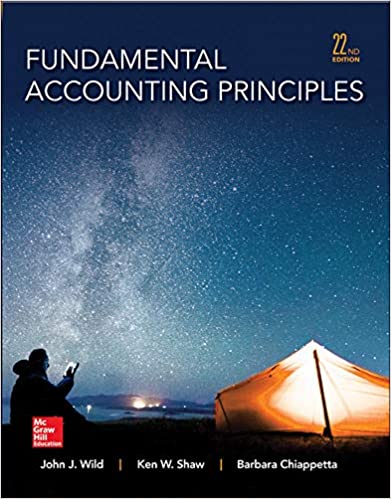
Fundamental Accounting Principles 22th Edition by John Wild ,Ken Shaw,Barbara Chiappetta
Edition 22ISBN: 978-0077862275
Fundamental Accounting Principles 22th Edition by John Wild ,Ken Shaw,Barbara Chiappetta
Edition 22ISBN: 978-0077862275 Exercise 81
Ming Chen began a professional practice on June 1 and plans to prepare financial statements at the end of each month. During June, Ming Chen (the owner) completed these transactions:
a. Owner invested $60,000 cash in the company along with equipment that had a $15,000 market value.
b. The company paid $1,500 cash for rent of office space for the month.
c. The company purchased $10,000 of additional equipment on credit (payment due within 30 days).
d. The company completed work for a client and immediately collected the $2,500 cash earned.
e. The company completed work for a client and sent a bill for $8,000 to be received within 30 days.
f. The company purchased additional equipment for $6,000 cash.
g. The company paid an assistant $3,000 cash as wages for the month.
h. The company collected $5,000 cash as a partial payment for the amount owed by the client in transaction e.
i. The company paid $10,000 cash to settle the liability created in transaction c.
j. Owner withdrew $1,000 cash from the company for personal use.
Required
Create a table like the one in Exhibit 1.9, using the following headings for columns: Cash; Accounts Receivable; Equipment; Accounts Payable; M. Chen, Capital; M. Chen, Withdrawals; Revenues; and Expenses. Then use additions and subtractions to show the effects of the transactions on individual items of the accounting equation. Show new balances after each transaction.
Reference: Exhibit 1.9

a. Owner invested $60,000 cash in the company along with equipment that had a $15,000 market value.
b. The company paid $1,500 cash for rent of office space for the month.
c. The company purchased $10,000 of additional equipment on credit (payment due within 30 days).
d. The company completed work for a client and immediately collected the $2,500 cash earned.
e. The company completed work for a client and sent a bill for $8,000 to be received within 30 days.
f. The company purchased additional equipment for $6,000 cash.
g. The company paid an assistant $3,000 cash as wages for the month.
h. The company collected $5,000 cash as a partial payment for the amount owed by the client in transaction e.
i. The company paid $10,000 cash to settle the liability created in transaction c.
j. Owner withdrew $1,000 cash from the company for personal use.
Required
Create a table like the one in Exhibit 1.9, using the following headings for columns: Cash; Accounts Receivable; Equipment; Accounts Payable; M. Chen, Capital; M. Chen, Withdrawals; Revenues; and Expenses. Then use additions and subtractions to show the effects of the transactions on individual items of the accounting equation. Show new balances after each transaction.
Reference: Exhibit 1.9

Explanation
Balance sheet
Balance sheet refers to t...
Fundamental Accounting Principles 22th Edition by John Wild ,Ken Shaw,Barbara Chiappetta
Why don’t you like this exercise?
Other Minimum 8 character and maximum 255 character
Character 255


